Viking Scandinavia 300 User Manual
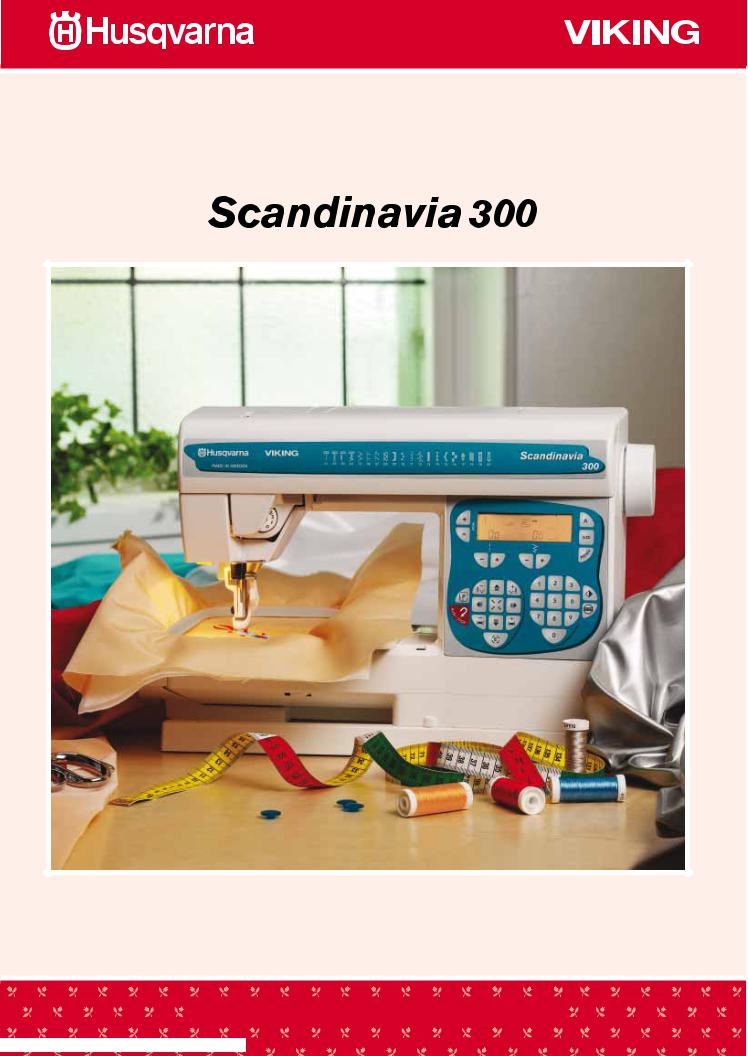
User’s Guide
 K E E P I N G T H E W O R L D S E W I N G
K E E P I N G T H E W O R L D S E W I N G
This household sewing machine is designed to comply with IEC/EN 60335-2-28 and UL1594
IMPORTANT SAFETY INSTRUCTIONS
When using an electrical appliance, basic safety precautions should always be followed, including the following:
Read all instructions before using this household sewing machine.
DANGER - To reduce the risk of electric shock:
•A sewing machine should never be left unattended when plugged in. Always unplug this sewing machine from the electric outlet immediately after using and before cleaning.
•Always unplug before relamping. Replace bulb with same type rated 5 Watt.
WARNING - To reduce the risk of burns, fire, electric shock, or injury to persons:
•Do not allow to be used as a toy. Close attention is necessary when this sewing machine is used by or near children or infirm persons.
•Use this sewing machine only for its intended use as described in this manual. Use only attachments recommended by the manufacturer as contained in this manual.
•Never operate this sewing machine if it has a damaged cord or plug, if it is not working properly, if it has been dropped or damaged, or dropped into water. Return the sewing machine to the nearest authorised dealer or service center for examination, repair, electrical or mechanical adjustment.
•Never operate the sewing machine with any air openings blocked. Keep ventilation openings of the sewing machine and foot controller free from the accumulation of lint, dust, and loose cloth.
•Keep fingers away from all moving parts. Special care is required around the Sewing machine needle.
•Always use the proper needle plate. The wrong plate can cause the needle to break.
•Do not use bent needles.
•Do not pull or push fabric while stitching. It may deflect the needle causing it to break.
•Switch the sewing machine off (“0”) when making any adjustment in the needle area, such as threading needle, changing needle, threading bobbin, or changing presser foot, etc.
•Always unplug the sewing machine from the electrical outlet when removing covers, lubricating, or when making any other user servicing adjustments mentioned in the instruction manual.
•Never drop or insert any object into any opening.
•Do not use outdoors.
•Do not operate where aerosol (spray) products are being used or where oxygen is being administrated.
•To disconnect, turn all controls to the off (“0”) position, then remove plug from outlet.
•Do not unplug by pulling on cord. To unplug, grasp the plug, not the cord.
•Hold plug when rewinding into cord reel. Do not allow plug to whip when rewinding.
SAVE THESE INSTRUCTIONS
Table of contents
Learn your Scandinavia 300
Overview
Unpacking, Packing away Connecting the foot control Connecting to the power supply Accessories
Spool pin
Threading the upper thread Threading for twin needles Bobbin winding
Threading lower thread Thread tension
Changing the presser foot Presser foot pressure Presser foot lever, Changing the needle Lowering feed teeth
Functions and Infodisplay
The functions panel Mirror image Embroidery functions
Optional Embroidery card
Embroidery
Get started
Embroidery presser foot Attach the Embroidery presser foot Removing/Connecting the Embroidery Unit Embroidery Hoop Embroidery template Sewing embroideries
2 |
Sewing |
31 |
|
2 |
Stitch table |
32 |
|
3 |
Buttonholes |
34 |
|
4 |
Buttonhole knife, Sewing buttons |
35 |
|
4 |
Straight stitch |
36 |
|
5 |
Gathering with straight stitches |
36 |
|
5 |
Needle positions |
37 |
|
6 |
Zipper |
38 |
|
7 |
Reinforced straight stitches |
39 |
|
8 |
Stretch stitch, Zigzag |
39 |
|
Lace edging |
40 |
||
9 |
|||
Three-step zigzag |
41 |
||
10 |
|||
Sewing terry cloth |
41 |
||
11 |
|||
Flatlock |
42 |
||
11 |
|||
Blind hem |
43 |
||
11 |
|||
Bridging stitch |
44 |
||
12 |
|||
Seam and Overcast |
44 |
||
12 |
|||
Applique |
45 |
||
13 |
|||
Satin taper and darning stitches |
45 |
||
14 |
|||
Darning stitch |
46 |
||
15 |
|||
Automatic taper stitch |
46 |
||
16 |
|||
Decorative stitches |
47 |
||
17 |
|||
Sewing hints |
48 |
||
|
|||
19 |
Free arm, Jeans hem, |
|
|
20 |
Sewing on belt loops |
48 |
|
21 |
Care of your Scandinavia 300 |
49 |
|
|
|||
21 |
Changing light bulb |
50 |
|
Care of the machine |
51 |
||
|
|||
22 |
Trouble shooting |
52 |
|
23 |
Index |
54 |
|
24 |
|||
|
|
||
25 |
|
|
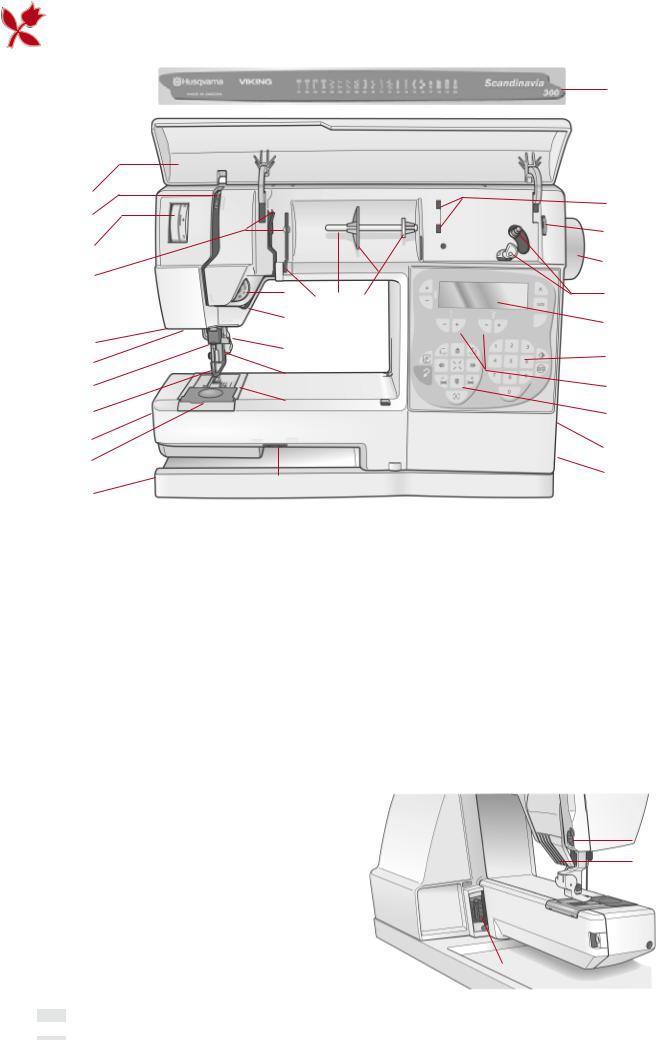
Learn your Scandinavia 300
Overview
31
1 |
|
|
|
|
21 |
|
|
|
|
|
|
2 |
|
|
|
|
22 |
3 |
|
|
|
|
|
|
|
|
|
23 |
|
4 |
|
|
|
|
|
|
|
|
|
|
|
|
17 |
18 |
19 |
20 |
24 |
|
|
||||
|
16 |
|
|
|
25 |
5 |
15 |
|
|
|
26 |
6 |
|
|
|
||
|
|
|
|
|
|
7 |
14 |
|
|
|
27 |
|
|
|
|
||
8 |
13 |
|
|
|
28 |
|
|
|
|
||
9 |
|
|
|
|
29 |
|
|
|
|
|
|
10 |
|
|
|
|
30 |
|
12 |
|
|
|
|
11 |
|
|
|
|
|
|
|
|
|
|
|
1. |
Lid |
|
|
24. |
Bobbin spindle, Bobbin stop |
2. |
Thread take-up lever |
|
|
25. |
Infodisplay |
3. |
Presser foot pressure dial |
|
|
26. |
Numeral buttons Stitch selection |
4. |
Thread guide |
|
|
27. |
Function buttons |
5. |
Buttonhole sensor socket |
|
|
28. |
Function buttons Embroidery |
6. |
Light |
|
|
29. |
Embroidery card slot |
7. |
Needle bar |
|
|
30. |
Main power switch, |
8. |
Presser foot |
|
|
|
Connection to power supply |
9. |
Free arm |
|
|
31. |
Stitch panel |
10. Bobbin cover |
|
|
32. |
Presser foot lever |
|
11. Base plate |
|
|
33. |
Thread cutter |
|
12. Drop feed dial |
|
|
34. |
Embroidery unit socket |
|
13.Needle plate
14.Presser bar
15.Needle clamp screw
16. |
Thread tension discs |
33 |
||
17. |
Thread tension indicator |
32 |
||
18. |
Thread guide for bobbin winding |
|
||
19. |
Spool pin |
|
||
20. |
Spool holders |
|
||
21. |
Recess for additional spool pin |
|
||
22. |
Thread cutter for bobbin winding |
34 |
||
23. |
Handwheel |
|||
|
||||
|
|
|
|
|
|
|
|
|
|
|
|
|
|
|

Embroidery Unit
35.Embroidery arm
36.Embroidery Hoop attachment
37.Embroidery unit socket
38.Release button
38
Unpacking
1.Place the machine on the table or cabinet, remove the packaging.
2.Remove the side parts of the packing material and the foot control.
3.The machine is delivered with a soft plastic cover, an accessory bag, a main cord and a foot control cord. There is also a test kit for embroidery and a bag containing embroidery accessories (see page 17).
4.Wipe the machine, particularly around the needle and needle plate to remove any soil before sewing.
Packing away after sewing
1. Unplug the cords from the wall socket and the machine. Wind the cords around your hand and place the foot control cord in the
foot control storage space. Place the foot control as illustrated. Lower the presser foot. Remove the embroidery card.
2. Slide the cover over the machine. Place the main cord in the pocket of the cover. There is
also space provided for the operating manual, the embroidery accessories and the other accessories.
Learn your Scandinavia 300
35
 36
36
37
3
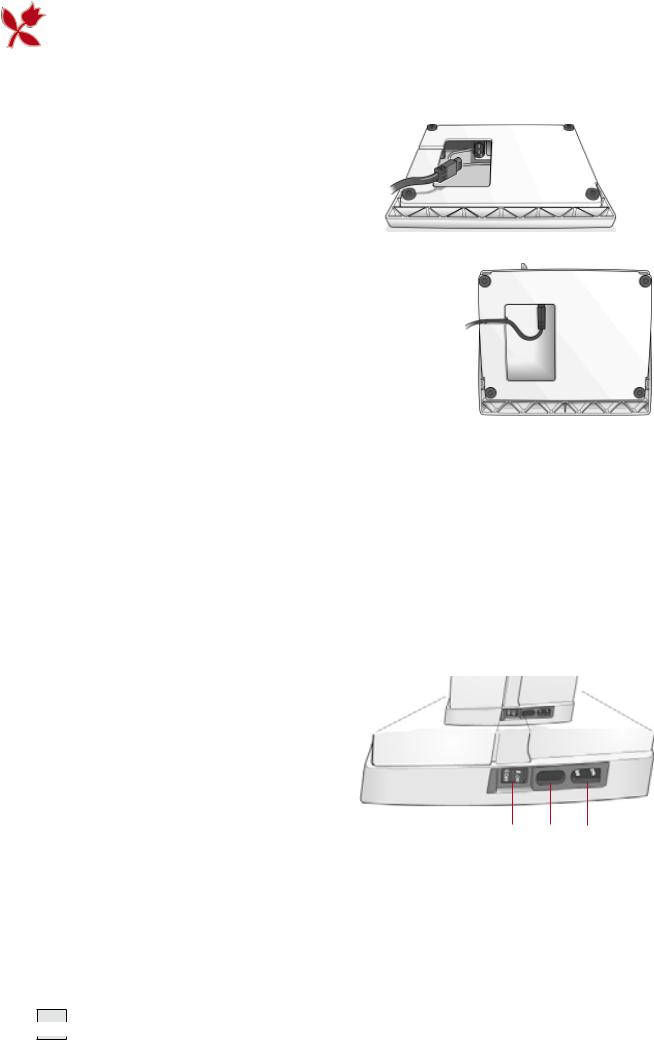
Learn your Scandinavia 300
Connecting the foot control
Among the accessories you will find the foot control cord and the main cord.
1.Place the foot control on its narrow side. Fit the plug into the socket inside the foot control compartment.
2.Push it firmly to make sure it
is properly connected. This operation is only necessary the very first time you are going to use the machine.
3. To correctly guide foot control cord, place it into the slot, see picture.
Note: Before plugging in, check to ensure that the foot control is of type "FR4".
Connecting to the power supply
1.Connect the foot control cord to the first socket on the lower right side of the machine.
2.Connect the main cord to the back socket on the lower right side of the machine.
3.When you press the power
switch, both the machine and the |
3 |
1 |
2 |
|
light are turned on. |
||||
|
|
|
For the USA and Canada
Husqvarna Viking Scandinavia 300 has a polarized plug (one blade wider than the other). To reduce the risk of electric shock, this plug is intended to fit in a polarized outlet only one way. If the plug does not fit fully in the outlet, reverse the plug. If it still does not fit, contact a qualified electrician to install the proper outlet. Do not modify the plug in any way.
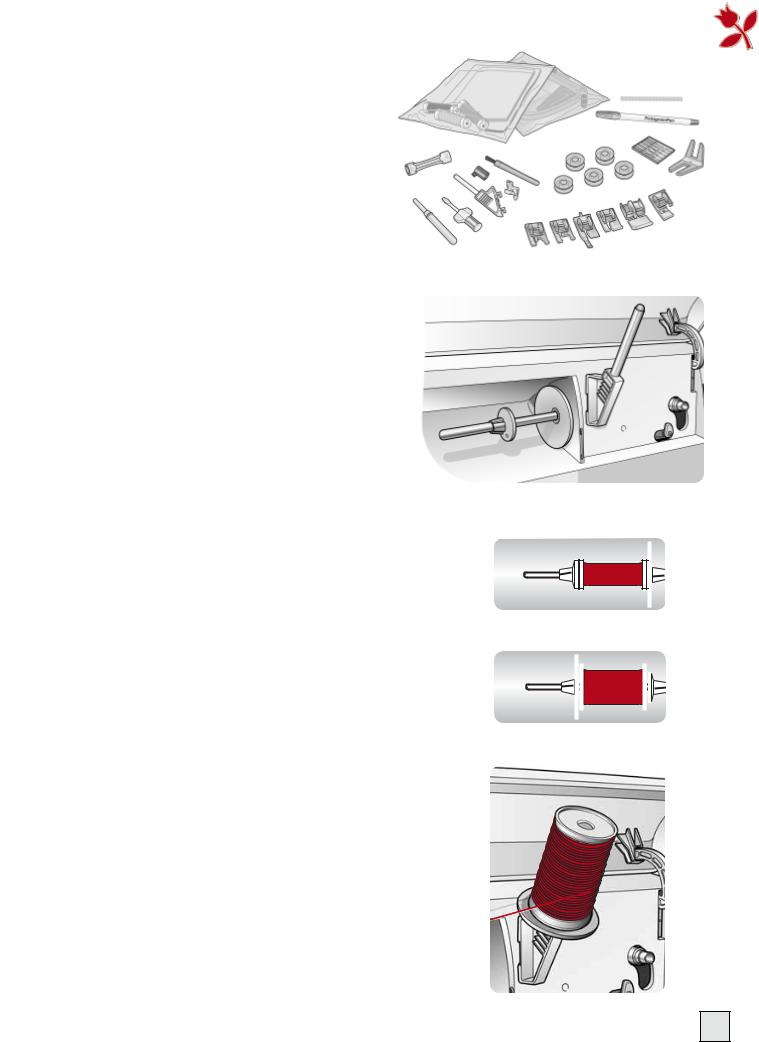
Learn your Scandinavia 300
Accessories
You will find a number of accessories included with your sewing machine. Learn to use them on the following pages of this User's Guide.
Spool pin
The machine has spool pins suitable for all types of thread. The main spool pin (a) is horizontal - the thread reels off the stationary spool. Place the spool so that the thread reels counter-clockwise.
There are two spool holders on the spool pin. With narrow thread
spools, the small holder (b) is placed in front of the thread. If you use large thread spools, the large holder
(c) is placed in front of the thread. Slide the correct size spool holder in place so the flat side is pressed firmly against the spool, with no space between spool holder and spool.
There is also a separate vertical spool pin (d) to be attached onto the machine. The fingers on the extra spool pin fit into the two holes to the right of the fixed spool pin. Push downward to snap in place. The large spool holder (c) is placed under the thread. This spool pin is used when winding a bobbin from a second spool of thread or for a second spool when sewing with a twin needle.
a |
b |
|
d |
||
|
c |
||||
|
|
||||
|
|
|
|
|
|
|
|
|
|
|
|
|
|
|
|
|
|
|
|
|
|
|
|
|
|
|
|
|
|
|
|
|
|
|
|
|
|
|
|
|
|
|
|
|
|
|
|
|
|
|
|
|
|
|
|
|
|
|
|
|
|
|
|
|
|
|
|
|
|
|
|
|
|
|
|
|
|
|
|
|
|
|
|
|
|
|
|
|
|
c
d
5
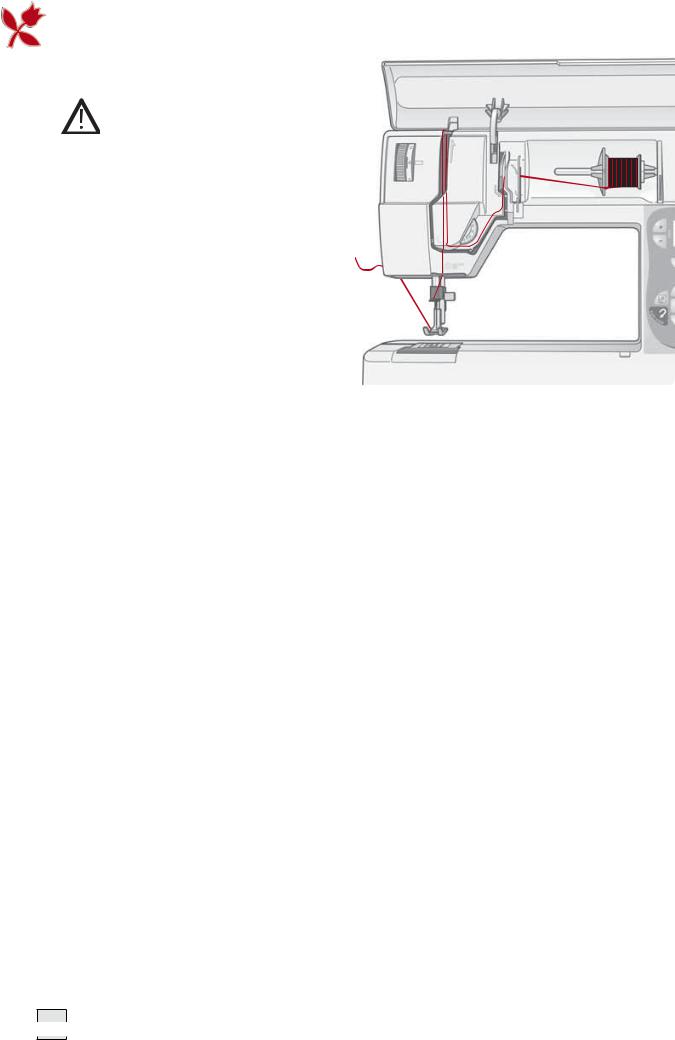
Learn your Scandinavia 300
Threading the upper thread
Turn off the main switch. |
|
Make sure the presser foot is raised |
|
and the needle is in the up position |
|
1. Pull the spool pin out. Place the |
|
thread on the spool pin and the |
|
spool holder on the spool pin |
7 |
as described. Push the spool pin |
|
back in. |
|
2.Bring the thread in the direction of the arrow under the thread guide (a) and over the thread guide (b).
3.Bring the thread down between the thread tension discs.
4.Continue threading by drawing the thread from the right into the slot on the take-up lever.
5.Thread last guide just above needle.
6.The needle is threaded from front to back. The white on the presser foot ankle makes it easy to see the eye of the needle.
7.Place thread under the presser foot and into the thread cutter where it is cut.
Upper thread warning
If the upper thread breaks or if thread spool runs out, the machine stops and gives a signal. The symbol  is flashing on the display.
is flashing on the display.
If thread breaks: Re-thread the machine. The symbol goes out. If thread spool runs out: Remove your work and the bobbin. Re-thread the machine. Replace the bobbin and restart.
4 |
2 |
1 |
a
b 
3
5
 6
6
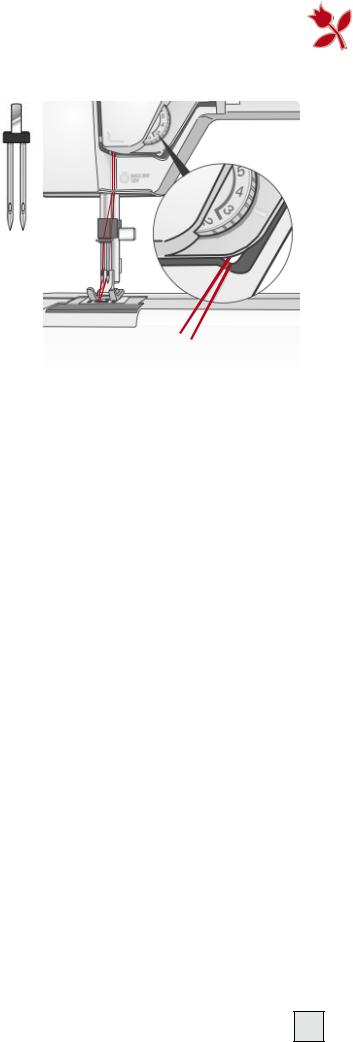
Learn your Scandinavia 300
Threading for twin needle
 Turn off the main switch.
Turn off the main switch.
Make sure the presser foot is raised and the needle is in the up position
1.Insert a twin needle (optional accessory).
2.Wind a bobbin with the thread you are going to use as the second upper thread.
3. Thread the machine as described and check to ensure that the thread lies between the inner thread tension discs, outside the lowest thread guide. Thread left needle.
4.Attach the extra spool pin onto the machine. Place a spool holder under the thread.
5.Place the bobbin with the second thread on the spool pin.
6.Thread the machine as before but this thread should lie between the outer thread tension discs, outside the lowest thread guide. Thread right needle.
7
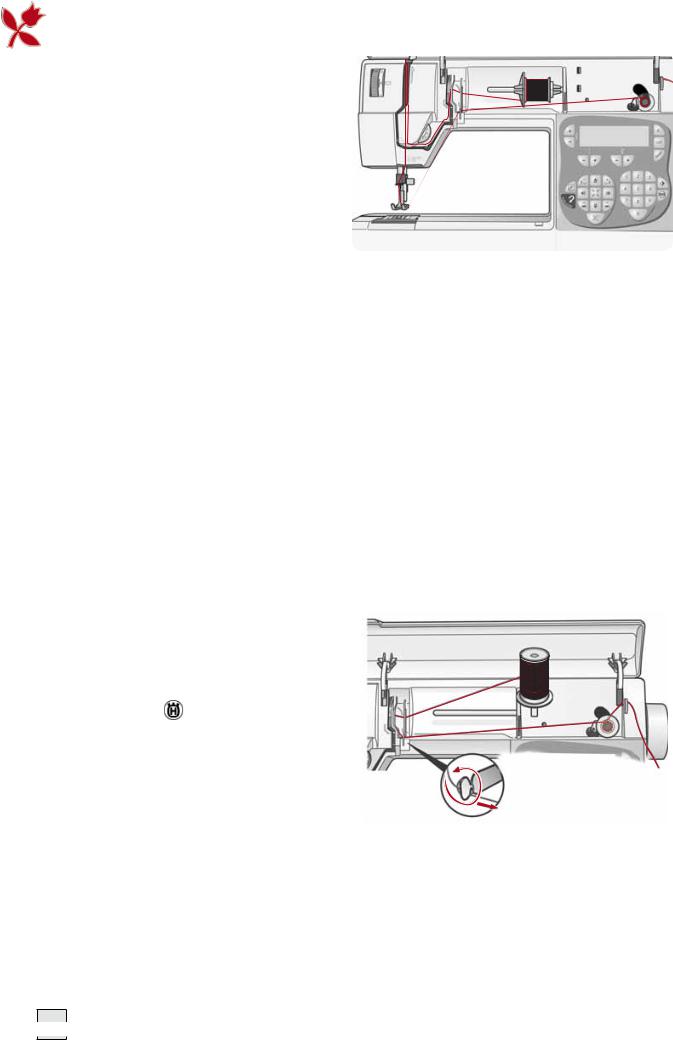
Learn your Scandinavia 300
Bobbin winding from the needle
Make sure that the presser foot is up and the needle is in the highest position.
Note! Do not use a plastic presser foot when bobbin winding.
1. Place your empty bobbin with the small mark  outwards on the bobbin spindle on the front of the machine.
outwards on the bobbin spindle on the front of the machine.
2.Pull the thread from the needle under the presser foot and to the right over the thread guide (c).
3.Start from above and wind a few turns of thread around the bobbin. Cut off the thread on the thread cutter(d).
4.Bring the bobbin spindle down. Press the foot control. When the
 d
d
c
bobbin winding is finished, the bobbin will stop automatically. Remove the bobbin, cut off the thread and bring the bobbin spindle up.
Note! We do not recommend winding specialty threads such as clear nylon or other stretchy threads through the needle. Instead see "Bobbin winding - vertical spool pin" below.
Bobbin winding - vertical spool pin
1. |
Place an empty bobbin with |
|
|
|
|
the mark |
outwards on the |
b |
a |
|
bobbin spindle on the front of the |
|
||
|
|
c |
||
|
machine. |
|
|
|
|
|
|
|
|
2. |
Place the large spool holder under |
|
|
|
|
the thread on the spool pin. |
|
|
|
3. |
Bring the thread under the thread |
5 . Bring the bobbin spindle down. |
||
|
guide (a) and over thread guide |
|||
|
(b),then |
around thread guide (c) Press the foot control. When the |
||
|
as illustrated. |
|
bobbin winding is finished, the |
|
4. |
From above wind a few turns of |
|
bobbin will stop automatically. |
|
|
thread around the bobbin and |
|
Remove the bobbin, cut off the |
|
|
into the cutter. |
|
thread and bring the bobbin |
|
|
|
|
|
spindle up. |

Learn your Scandinavia 300
Threading lower thread
 Turn off the main switch.
Turn off the main switch.
1.Open the cover by slightly pulling it towards you and take it away.
2.Place the bobbin in the bobbin
case with the mark  facing upward and the thread to the left of the bobbin. The bobbin will then rotate counter clockwise when pulling the thread.
facing upward and the thread to the left of the bobbin. The bobbin will then rotate counter clockwise when pulling the thread.
3.Hold the bobbin and pull the thread to the right passing (a).
4.Hold the thread tight and pull it to the left so that the thread falls correctly into the tension spring. Continue threading around (b) and to the right of the thread
cutter(c).
Replace the cover and slide it into position. Then pull the thread to the left to cut it.
1


 10 15
10 15
2
3 |
4 |
|
|
b |
|
a |
c |
1 |
|
2 |
|
9

Learn your Scandinavia 300
Thread tension
The thread tension is adjusted automatically when you select a stitch or an embroidery. This is shown by the thread tension
indicator being reset. Do not turn this dial manually
You can adjust the thread tension by pressing the buttons, see page 14. Using the button
(-) you decrease the tension and using the button (+) you increase the tension. The adjustment affects all stitches and will remain until the machine is turned off or until changed manualy.
Normal thread tension is 4.
When selecting buttonholes and decorative stitches the thread tension is reduced.
When topstitching with a heavy thread in thick fabric, increase the tension to 7-9.
When the machine is turned on, the tension is set to normal automatically.
Correct and incorrect thread tension
To understand the correct thread tension, sew a few sample stitches at different settings.
Adjust tension only with the function buttons (see page 14). Do not turn dial.
1.Begin with a tension that is too loose, i.e. set at "1". The lower thread will lie straight and the upper thread will be drawn down on the underside.
2.If you set the tension at the highest number, the opposite will occur, and the seam may pucker.
3.When thread tension is correctly set the threads interlock in the middle of both layers of material
1
2
3
or, in the case of decorative stitches, on the underside.
Note! Make a few tests on a scrap piece of the material you are going to sew and check the tension.
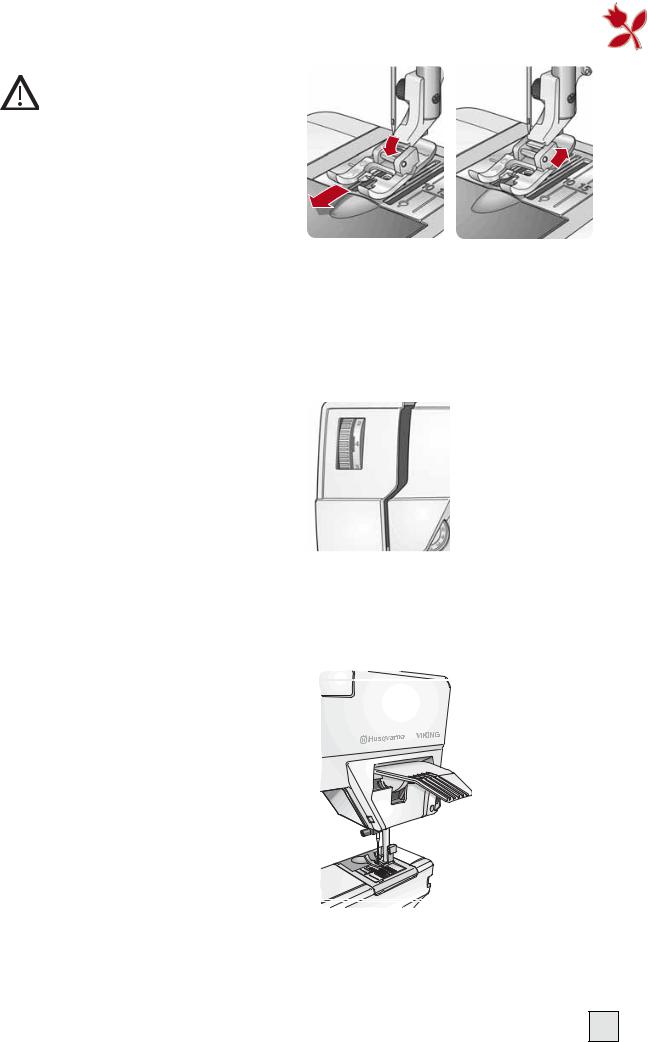
|
Learn your Scandinavia 300 |
Changing the presser foot |
2 |
1 |
Turn off the main switch.
1. Make sure that the needle is in the highest position. Pull the presser foot down and towards you.
2. Line up the cross pin on the foot between the spring and the presser foot ankle. Press back until the foot snaps into place.
Presser foot pressure (a)
The presser foot pressure is adjusted with the dial on the front
of the machine. Normal setting is a 4. The higher the number the more
pressure on the fabric. Knit and Soft fabrics should be sewn with less pressure, 3-2.
Presser foot lever (b)
The presser foot is raised and |
|
lowered with the presser foot lever. |
|
The presser foot must be lowered |
b |
when sewing. The machine will |
|
not start if the presser foot is in the |
|
raised position. |
|
By raising the presser foot lever as far as it goes and holding it there, the lift height of the presser foot can be increased to place thick fabric an slide on or remove hoop.
11

Learn your Scandinavia 300
Changing the needle
 Turn off the main switch.
Turn off the main switch.
1.Loosen the screw in the needle clamp.
2.Remove the needle.
3.Push up the new needle with the flat side away from you until it will go no further.
4.Tighten the screw properly.
Always use needles of system 130/705H.
Lowering the feed teeth
The feed teeth are lowered automatically when the embroidery unit is in place.
When removing the embroidery unit, the feed teeth will raise as you start to sew.
The feed teeth are lowered when you turn the dial to the left to  . Turn the dial to the right to
. Turn the dial to the right to  if you wish to raise the feed teeth. The feed teeth will not come up until you begin to sew.
if you wish to raise the feed teeth. The feed teeth will not come up until you begin to sew.
Lower the feed teeth for sewing buttons and for free motion quilting and emroidery.
By lowering the feed teeth it is easier to get thick garments under the presser foot. Do not forget to raise the feed teeth before starting to sew.
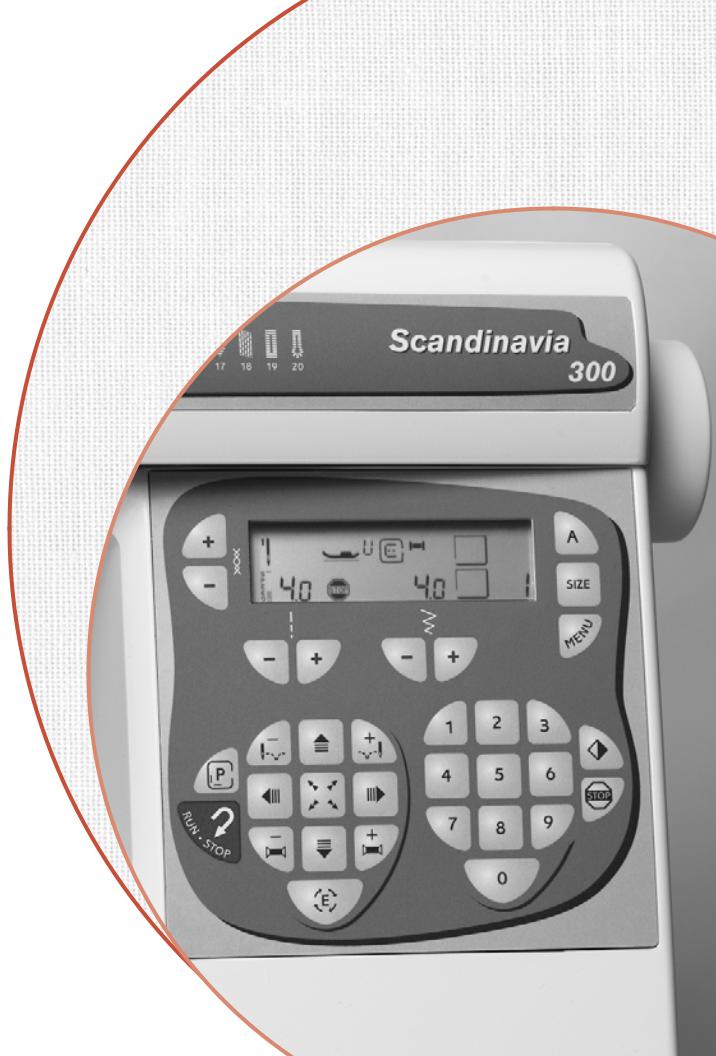
FUNCTIONS AND INFODISPLAY
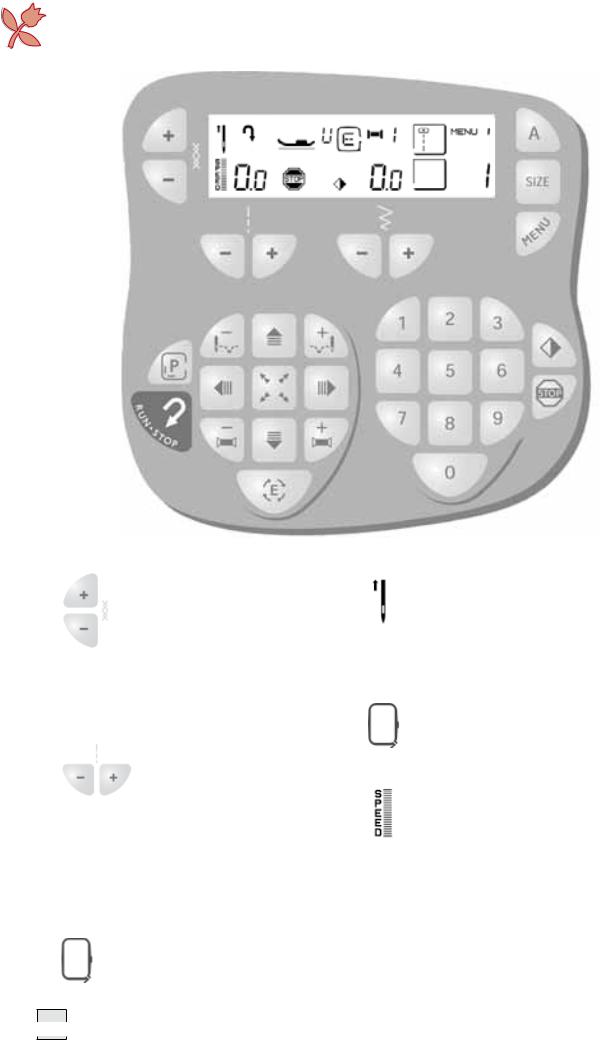
Functions and InfoDisplay
Functions and Infodisplay
1 |
3 |
6 |
10 11 |
9 |
|
|
|
|
4 |
2 |
7 |
8 |
5 |
9 |
2 |
|
|
5 |
|
|
8
7
6
1.Thread tension - adjustment
Use these buttons to adjust the thread tension manually. The adjustment affects all stitches and will remain until
the machine is turned off or until reset manually.
2. Stitch length
When you select a stitch, the machine will automatically set the best
stitch length which will be indicated by numbers on the Infodisplay. You can change the stitch length by pressing either the (+) or (-) button. Certain stitches have a limited stitch length.
When sewing embroideries the length can be set between 2 and 6 to change size of embroidery.
9
3. Needle stop recommendation
This symbol shows the normal stop position of the needle, up. You regulate the needle
stop position with the foot control. To raise or lower the needle after stopping, lightly tap the foot control.
When sewing embroideries only the up position can be used.
4. Sewing speed
This symbol shows the sewing speed for the actual stitch/ embroidery.
All stitches in the machine have a pre-set maximum speed at which they can be sewn. When you select a stitch the machine automatically sets the correct maximum speed.
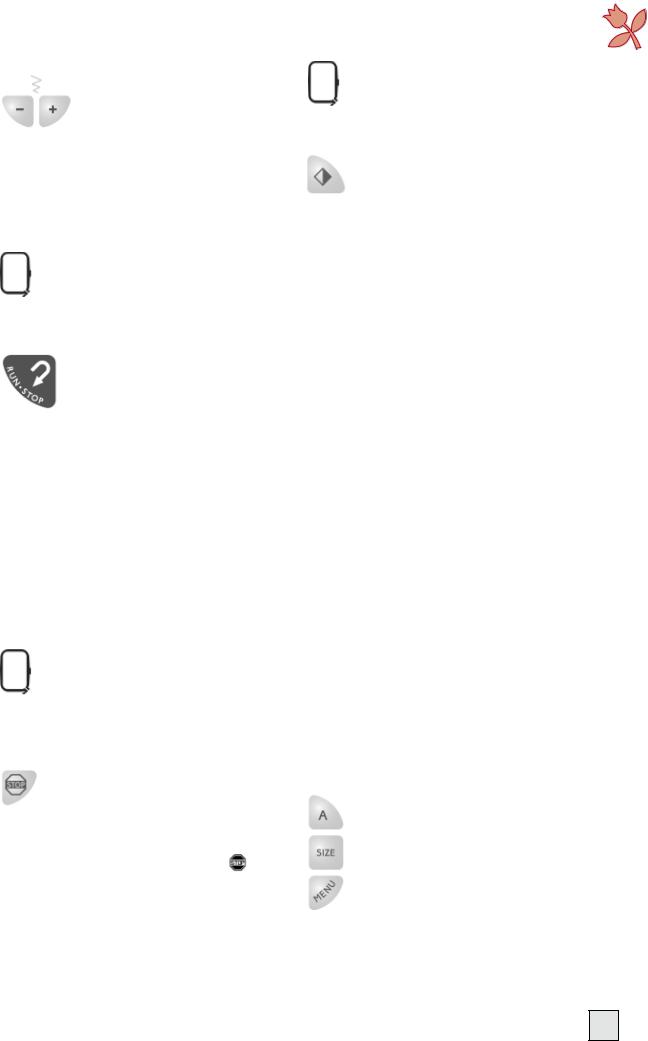
Functions and InfoDisplay
5. Stitch width
When you select a stitch, the machine automatically sets the best stitch width
which is displayed with numbers on the Infodisplay. You can change the stitch width by pressing the (+) or (-) button. The width can be adjusted between 0 and 6 mm.
When sewing embroideries the width can be set between 2 and 6, to change size of embroidery.
6. Reverse
Your machine sews backwards when this button is pressed. The machine sews
forward when the button is released. The longest stitch length when reverse feeding is 3 mm.
For permanent reverse, press the button twice in quick succession before starting to sew. An arrow  to the top left on the display indicates reverse sewing. To sew
to the top left on the display indicates reverse sewing. To sew
forward again, press the button once more.
The reverse button is also used when starting and stopping embroidery. (The foot control
can also be used).
7. STOP |
|
|
The |
STOP button is used to |
|
finish a stitch. i.e. the machine |
||
fastens the thread and stops |
|
|
automatically when the stitch has |
||
been completed. The symbol |
on |
|
the display indicates that |
STOP |
|
selected. |
STOP is cancelled when |
|
you press the button again or select a new stitch.
(See ”Satin taper...”, page 45.)
For Embroidery sewing without thread color change stops, see page 27.
8. Mirror image
You can mirror a stitch by using the button  , mirror
, mirror
image side to side. The symbol  will be displayed.
will be displayed.
9. Stitch/Embroidery selection
The machine has one row of stitches shown on the front of the lid. To select a stitch or an embroidery, touch the numeral buttons - for example 1, 2 to select stitch or embroidery number 12.
10. Recommended presser foot
The letter shows which presser foot is correct for the stitch you have selected. The corresponding letter is found on the presser foot.
11. Embroidery
Refer to pages 19-30
11. Sewing - Optional - Sensor buttonhole foot
When you plug the optional Sensor Buttonhole Foot into the socket
on the machine near the light, and placwe the white field of the measurement wheel against the
white mark, the symbol  will be show brightly on the display.
will be show brightly on the display.
Optional Accessories -
Letters
As an optional accessory an is embroidery card containing three different font styles are
available. These buttons are used with this embroidery card. Read more about these buttons on page 17.
15
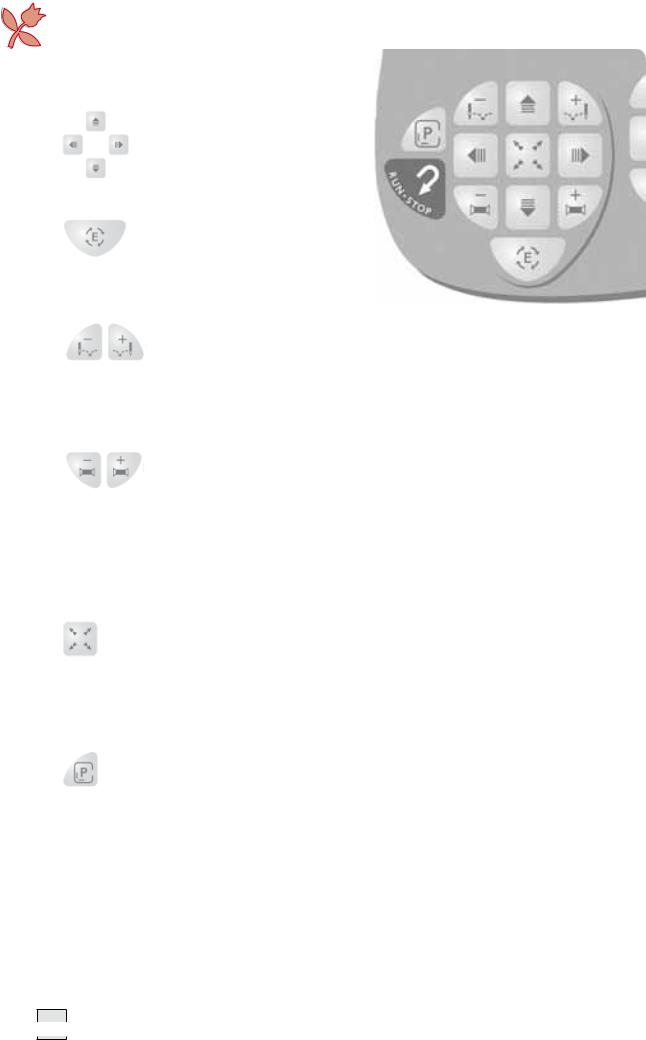
Functions and InfoDisplay
Functions / Embroidery
Positioning
These buttons allow you to move the embroidery in four directions.
Rotation
Touch this button once and your embroidery will rotate
a quarter of a turn.
Stitch advance
These buttons allow you to step stitch by stitch
forward (+) or backward (-) within your embroidery.
Color advance
Many of the embroideries have color changes.
These buttons allow you to step forward (+) or backward (-) to the beginning of each thread color change.
Check size
This button allow you to step from one corner to another
within your embroidery to check the finished size of your design.
When your embroidery is finished, touch this button. The embroidery arm returns to
parking position. The embroidery unit can now be removed. Read more about embroidery sewing on page 19-30.
